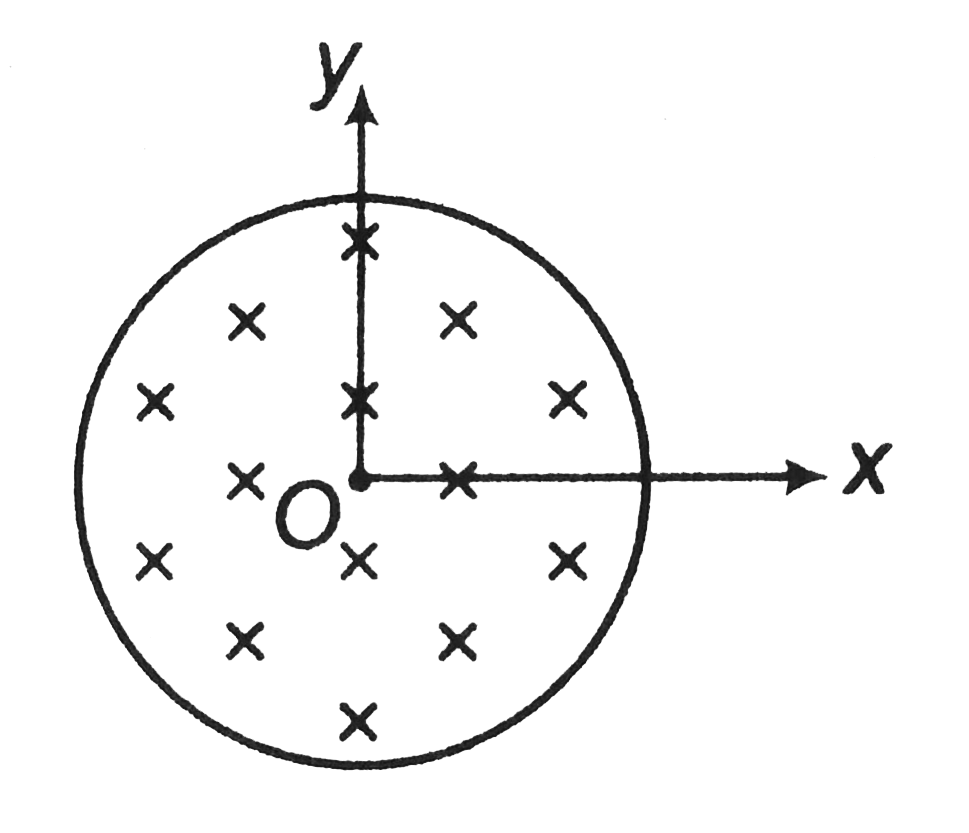Magnetic field in cylindrical region of radius R in inward direction is as shown in figure.

An electron will experience no force kept at (2P,0,0) if magnetic field increase with time
In the above situation, electron will experience the force in negative y-axis
If a proton is kept at (0,R2,0) and magnetic field is decreasing, then it will experience the force in positive x-direction.
If a proton is kept at (-R,0,0) and magnetic field is increasing , then it will experience force in negative y-axis
The correct Answer is:A, B, C
Step by step video, text & image solution for Magnetic field in cylindrical region of radius R in inward direction is as shown in figure. by Physics experts to help you in doubts & scoring excellent marks in Class 12 exams.
Updated on:21/07/2023Topper's Solved these Questions
- ELECTROMAGNETIC INDUCTION AND ALTERNATING CURRENTBook:PHYSICS GALAXY - ASHISH ARORAChapter:ELECTROMAGNETIC INDUCTION AND ALTERNATING CURRENTExercise:Numerical MCQs
Explore 60 Videos
- CURRENT ELECTRICITYBook:PHYSICS GALAXY - ASHISH ARORAChapter:CURRENT ELECTRICITYExercise:All Questions
Explore 389 Videos
- ELECTROSTATICSBook:PHYSICS GALAXY - ASHISH ARORAChapter:ELECTROSTATICSExercise:Unsolved Numberical Problems
Explore 73 Videos
Similar Questions
A unifrom magnetic field B exists in a cylindrical region of radius 1 cm as shown in figure. A uniform wire of length 16 cm and resistance 4.0Ω is bent into a square frame and is placed with one side along a diameters of the cylindrical region. If the magnetic field increaes at a constant rate of 1 T/s find the current induced in the frame.

View SolutionA rod AB of length L is placed in a cylindrical region time varying magnetic field as shown in figure-5.360 , with the rate of increasing magnetic induction C T/s. find the potential difference across ends of rod due to induced electric field in the region.

View Solution
Knowledge Check
A uniform magnetic field B exists in a cylindrical region of radius I0cm as shown in figure. A uniform wire or length 80cm and resistance 44.0Ω is bent into a square frame and is placed with one side along a diameter of the cylindrical region. if the magnetic field increases at a constant rate of 0.0I0T/sec , the current induced in the frame
 A3.9×10−5AB4.0×10−5AC4.1×10−5AD3.9×10−4A
A3.9×10−5AB4.0×10−5AC4.1×10−5AD3.9×10−4AA time varying magnetic field is present in a cylindrical region of radius R as shown in figure ( cross - sectional view ). B is increasing with time, mark out the correct statement (s) for the given situation, r being the distance from centre of cylindrical region.
 AFor r<R, the induced electric field is proportional to rBFor r>R, the induced electric field is proprotional to 1RCFor r=R, the induced electric field is maximumDIf a coaxial "non- conducting"ring of radius R2 is placed in the magnetic field region, then emf induced in the ring is παR24
AFor r<R, the induced electric field is proportional to rBFor r>R, the induced electric field is proprotional to 1RCFor r=R, the induced electric field is maximumDIf a coaxial "non- conducting"ring of radius R2 is placed in the magnetic field region, then emf induced in the ring is παR24In a region of space, magnetic field exists in a cylindrical region of radius a centred at origin with magnetic field along negative z-direction. The field is given by →B=−B0tˆk. The force experienced by a stationary charge q placed at (r, 0, 0), where r>a is
AqB0BqB0a22rCqB0r2DZero
Magnetic field B in a cylindrical region of radius r varies according to the law B=B0t as shown in the figure. A fixed conducting loop ABCDA of resistance R is lying in the region as show . The current flowing through the loop is

View SolutionA uniform but time varying magnetic field B=(2t3+24t)T is present in a cylindrical region of radius R=2.5cm as shown in figure.

In the previous problem, the direction of circular electric lines at t=1s is
View SolutionA uniform but time varying magnetic field B=(2t3+24t)T is present in a cylindrical region of radius R=2.5cm as shown in figure.

The variation of electric field at any instant as a function of distance measured from the centre of cylinder in first problem is
View SolutionA uniform but time varying magnetic field B=(2t3+24t)T is present in a cylindrical region of radius R=2.5 cm as shown in figure.

The force on an electron at P at t=2.0 s is
View SolutionA time varying magnetic field B=Kr3t is existing in a cylindrical region of radius 'R' as shown (where k is a constant). The induced electric field 'E' at rR2 is

View Solution

